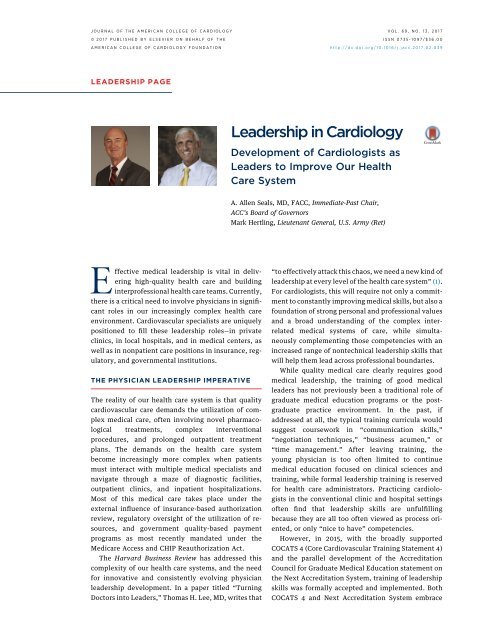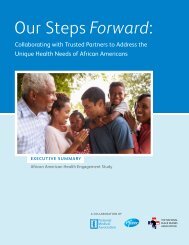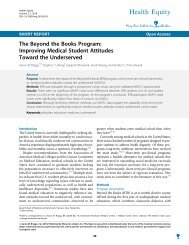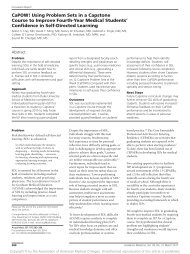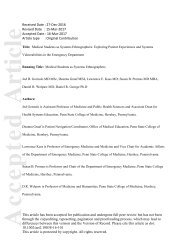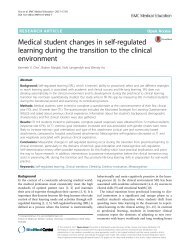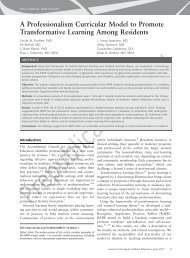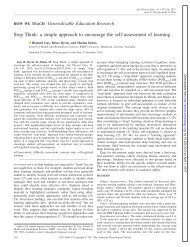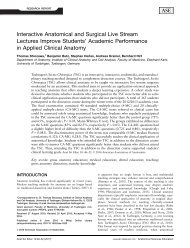Self-Reflection - Catalyst in Cardiology
You also want an ePaper? Increase the reach of your titles
YUMPU automatically turns print PDFs into web optimized ePapers that Google loves.
JOURNAL OF THE AMERICAN COLLEGE OF CARDIOLOGY VOL. 69, NO. 13, 2017<br />
ª 2017 PUBLISHED BY ELSEVIER ON BEHALF OF THE<br />
AMERICAN COLLEGE OF CARDIOLOGY FOUNDATION<br />
ISSN 0735-1097/$36.00<br />
http://dx.doi.org/10.1016/j.jacc.2017.02.039<br />
LEADERSHIP PAGE<br />
Leadership <strong>in</strong> <strong>Cardiology</strong><br />
Development of Cardiologists as<br />
Leaders to Improve Our Health<br />
Care System<br />
A. Allen Seals, MD, FACC, Immediate-Past Chair,<br />
ACC’s Board of Governors<br />
Mark Hertl<strong>in</strong>g, Lieutenant General, U.S. Army (Ret)<br />
Effective medical leadership is vital <strong>in</strong> deliver<strong>in</strong>g<br />
high-quality health care and build<strong>in</strong>g<br />
<strong>in</strong>terprofessional health care teams. Currently,<br />
there is a critical need to <strong>in</strong>volve physicians <strong>in</strong> significant<br />
roles <strong>in</strong> our <strong>in</strong>creas<strong>in</strong>gly complex health care<br />
environment. Cardiovascular specialists are uniquely<br />
positioned to fill these leadership roles—<strong>in</strong> private<br />
cl<strong>in</strong>ics, <strong>in</strong> local hospitals, and <strong>in</strong> medical centers, as<br />
well as <strong>in</strong> nonpatient care positions <strong>in</strong> <strong>in</strong>surance, regulatory,<br />
and governmental <strong>in</strong>stitutions.<br />
THE PHYSICIAN LEADERSHIP IMPERATIVE<br />
The reality of our health care system is that quality<br />
cardiovascular care demands the utilization of complex<br />
medical care, often <strong>in</strong>volv<strong>in</strong>g novel pharmacological<br />
treatments, complex <strong>in</strong>terventional<br />
procedures, and prolonged outpatient treatment<br />
plans. The demands on the health care system<br />
become <strong>in</strong>creas<strong>in</strong>gly more complex when patients<br />
must <strong>in</strong>teract with multiple medical specialists and<br />
navigate through a maze of diagnostic facilities,<br />
outpatient cl<strong>in</strong>ics, and <strong>in</strong>patient hospitalizations.<br />
Most of this medical care takes place under the<br />
external <strong>in</strong>fluence of <strong>in</strong>surance-based authorization<br />
review, regulatory oversight of the utilization of resources,<br />
and government quality-based payment<br />
programs as most recently mandated under the<br />
Medicare Access and CHIP Reauthorization Act.<br />
The Harvard Bus<strong>in</strong>ess Review has addressed this<br />
complexity of our health care systems, and the need<br />
for <strong>in</strong>novative and consistently evolv<strong>in</strong>g physician<br />
leadership development. In a paper titled “Turn<strong>in</strong>g<br />
Doctors <strong>in</strong>to Leaders,” Thomas H. Lee, MD, writes that<br />
“to effectively attack this chaos, we need a new k<strong>in</strong>d of<br />
leadership at every level of the health care system” (1).<br />
For cardiologists, this will require not only a commitment<br />
to constantly improv<strong>in</strong>g medical skills, but also a<br />
foundation of strong personal and professional values<br />
and a broad understand<strong>in</strong>g of the complex <strong>in</strong>terrelated<br />
medical systems of care, while simultaneously<br />
complement<strong>in</strong>g those competencies with an<br />
<strong>in</strong>creased range of nontechnical leadership skills that<br />
will help them lead across professional boundaries.<br />
While quality medical care clearly requires good<br />
medical leadership, the tra<strong>in</strong><strong>in</strong>g of good medical<br />
leaders has not previously been a traditional role of<br />
graduate medical education programs or the postgraduate<br />
practice environment. In the past, if<br />
addressed at all, the typical tra<strong>in</strong><strong>in</strong>g curricula would<br />
suggest coursework <strong>in</strong> “communication skills,”<br />
“negotiation techniques,” “bus<strong>in</strong>ess acumen,” or<br />
“time management.” After leav<strong>in</strong>g tra<strong>in</strong><strong>in</strong>g, the<br />
young physician is too often limited to cont<strong>in</strong>ue<br />
medical education focused on cl<strong>in</strong>ical sciences and<br />
tra<strong>in</strong><strong>in</strong>g, while formal leadership tra<strong>in</strong><strong>in</strong>g is reserved<br />
for health care adm<strong>in</strong>istrators. Practic<strong>in</strong>g cardiologists<br />
<strong>in</strong> the conventional cl<strong>in</strong>ic and hospital sett<strong>in</strong>gs<br />
often f<strong>in</strong>d that leadership skills are unfulfill<strong>in</strong>g<br />
because they are all too often viewed as process oriented,<br />
or only “nice to have” competencies.<br />
However, <strong>in</strong> 2015, with the broadly supported<br />
COCATS 4 (Core Cardiovascular Tra<strong>in</strong><strong>in</strong>g Statement 4)<br />
and the parallel development of the Accreditation<br />
Council for Graduate Medical Education statement on<br />
the Next Accreditation System, tra<strong>in</strong><strong>in</strong>g of leadership<br />
skills was formally accepted and implemented. Both<br />
COCATS 4 and Next Accreditation System embrace
JACC VOL. 69, NO. 13, 2017<br />
APRIL 4, 2017:1744– 7<br />
Seals and Hertl<strong>in</strong>g<br />
Leadership Page<br />
1745<br />
the philosophy that modern-day cardiologists<br />
“participate <strong>in</strong> a team-based system, use <strong>in</strong>formation<br />
technology, practice cost-effective medic<strong>in</strong>e, and<br />
importantly, help them function as a health care<br />
leader” (2).<br />
TRANSLATING THE MILITARY LEADERSHIP<br />
MODEL TO THE HEALTH CARE LANDSCAPE<br />
A few years ago, a hospital system <strong>in</strong> Florida began<br />
us<strong>in</strong>g a military tra<strong>in</strong><strong>in</strong>g model to contribute to<br />
improv<strong>in</strong>g the leader attributes and competencies<br />
possessed by their physicians. Adapt<strong>in</strong>g a def<strong>in</strong>ition of<br />
leadership used by soldiers, this program further<br />
ref<strong>in</strong>ed an encompass<strong>in</strong>g def<strong>in</strong>ition of leadership that<br />
could guide physicians <strong>in</strong> improv<strong>in</strong>g health care teams<br />
and patient engagement (3). That def<strong>in</strong>ition, borrowed<br />
from a military tra<strong>in</strong><strong>in</strong>g manual, but adapted to<br />
the demands of health care, reads that “leadership is<br />
the art of understand<strong>in</strong>g motivations, <strong>in</strong>fluenc<strong>in</strong>g<br />
people and teams, and communicat<strong>in</strong>g purpose and<br />
direction to accomplish stated goals while improv<strong>in</strong>g<br />
the organization” (4). In the U.S. military—like <strong>in</strong><br />
medic<strong>in</strong>e—life or death scenarios are often presented.<br />
Similarly, <strong>in</strong> the military as it is <strong>in</strong> medic<strong>in</strong>e, it is a<br />
requirement of leaders to br<strong>in</strong>g a group of differentially<br />
skilled <strong>in</strong>dividuals together as a highperform<strong>in</strong>g<br />
team to succeed <strong>in</strong> a mission. Although<br />
at first the military is seem<strong>in</strong>gly an unlikely source for<br />
leadership skills <strong>in</strong> health care, the U.S. Army employs<br />
a number of applicable and simple techniques and<br />
models to build leadership skills. One of the most<br />
translatable of these is the “Be, Know, Do” leadership<br />
model. The “Be” is all about character. It reflects who<br />
a leader is and how he or she is perceived. The “Know”<br />
is a leader’s knowledge and understand<strong>in</strong>g of skills<br />
required to do his or her job and perform. F<strong>in</strong>ally,<br />
“Do” is where action takes hold—how does the leader<br />
generate trust? How does the leader develop others to<br />
contribute to the organization to accomplish goals and<br />
meet the mission? Although the “Be” and “Know”<br />
tenets of this leadership model are <strong>in</strong>credibly important,<br />
it is <strong>in</strong> the action-oriented “Do” portion where<br />
leaders can struggle. Failure <strong>in</strong> leadership occurs<br />
when an idea or decision makes it to the po<strong>in</strong>t of action,<br />
and there is no one there to drive it to f<strong>in</strong>ality.<br />
The core of leadership is that effective leaders take<br />
action and get th<strong>in</strong>gs done.<br />
WHAT MAKES AN EFFECTIVE LEADER?<br />
Two concepts help def<strong>in</strong>e an effective leader: <strong>in</strong>dividual<br />
attributes and emotional <strong>in</strong>telligence. The<br />
development of strong personal and professional<br />
values rema<strong>in</strong>s the most fundamental prerequisite for<br />
the <strong>in</strong>dividual character that def<strong>in</strong>es an effective<br />
leader. Most leaders come to the table with the best of<br />
<strong>in</strong>tentions, but unfortunately these <strong>in</strong>dividuals typically<br />
lead with only 1 lens—their own. It is not until<br />
leaders take a look around—ga<strong>in</strong> situational understand<strong>in</strong>g,<br />
sense the culture and the dynamics of<br />
the surround<strong>in</strong>gs, and gather feedback—that their selfperception<br />
is either validated or disproved. <strong>Self</strong>awareness,<br />
a key component embedded <strong>in</strong> <strong>in</strong>dividual<br />
attributes and emotional <strong>in</strong>telligence, is a key factor of<br />
lead<strong>in</strong>g effectively. The higher the level of leadership,<br />
the more crucial personal character becomes, and <strong>in</strong><br />
fact, <strong>in</strong>dividual attributes and emotional <strong>in</strong>telligence<br />
often trump scholarly <strong>in</strong>telligence <strong>in</strong> contribut<strong>in</strong>g to<br />
leadership effectiveness. Thus, <strong>in</strong> the health care<br />
management sett<strong>in</strong>g requir<strong>in</strong>g effective leadership,<br />
there is an <strong>in</strong>creas<strong>in</strong>g need to focus on competencies<br />
related to how we work together, communicate with<br />
each other, and manage positive change (3).<br />
Effective leaders cannot rema<strong>in</strong> effective if they<br />
lose their sense of humility and self. Whether one is<br />
serv<strong>in</strong>g as an Army commander or as a physician<br />
medical director <strong>in</strong> a hospital, self-reflection is an<br />
important part of the leadership journey. Harvard<br />
Bus<strong>in</strong>ess Review author Anthony K. Tjan states this<br />
same self-awareness “.allows the best bus<strong>in</strong>essbuilders<br />
to walk the tightrope of leadership: project<strong>in</strong>g<br />
conviction while simultaneously rema<strong>in</strong><strong>in</strong>g<br />
humble enough to be open to new ideas and oppos<strong>in</strong>g<br />
op<strong>in</strong>ions” (5).<br />
Cardiovascular professionals operate with<strong>in</strong><br />
constantly shift<strong>in</strong>g local environments and a rapidly<br />
chang<strong>in</strong>g national health care landscape. It is no<br />
surprise that leaders <strong>in</strong> health care often only focus<br />
on the task at hand. In contrast, an effective physician<br />
leader considers how to lead from a 360 <br />
perspective, and proven and accomplished leaders<br />
demonstrate the ability to <strong>in</strong>corporate new ideas and<br />
concepts each day and over time. Stakeholders matter<br />
and their perception of how physician leaders<br />
execute their role matters even more. Leaders must<br />
take the time to seek feedback from these <strong>in</strong>volved<br />
stakeholders, actively engage peer colleagues, as well<br />
as seek advice from other team members. And, while<br />
do<strong>in</strong>g so, the leader must actively listen and be prepared<br />
for honest critiques. As the Greek philosopher<br />
Epictetus wrote, “We have two ears and one mouth so<br />
that we can listen twice as much as we speak” (6).<br />
ORGANIZATIONAL COMPETENCIES<br />
Beyond the fundamentals of personal character (<strong>in</strong>tellectual<br />
attributes and emotional <strong>in</strong>telligence),
1746<br />
Seals and Hertl<strong>in</strong>g JACC VOL. 69, NO. 13, 2017<br />
Leadership Page APRIL 4, 2017:1744– 7<br />
organizational-based leadership skills or competencies<br />
are also critical to effective leadership. Most<br />
organizations ma<strong>in</strong>ta<strong>in</strong> a set of core leadership skills<br />
that are critical to conduct<strong>in</strong>g bus<strong>in</strong>ess each day.<br />
These leadership skills, or competencies, are reflective<br />
of one’s culture and leadership expectation. The<br />
military uses a “leadership requirements model” that,<br />
based on years of research, centers on who the leader<br />
is and what the leader knows—or the leader’s attributes—and<br />
what the leaders does—or his or her competencies<br />
(3).<br />
The American College of <strong>Cardiology</strong> (ACC), as part<br />
of its new governance transformation, is lead<strong>in</strong>g the<br />
way <strong>in</strong> physician professionalism and leader development<br />
by def<strong>in</strong><strong>in</strong>g key leadership competencies and<br />
<strong>in</strong>corporat<strong>in</strong>g them <strong>in</strong>to the organizational structure<br />
of the College. Beg<strong>in</strong>n<strong>in</strong>g with the Board of Trustees,<br />
these pr<strong>in</strong>ciples of leadership competency are now<br />
be<strong>in</strong>g implemented through the entire ACC leadership<br />
structure—<strong>in</strong>clud<strong>in</strong>g selection of chairs and<br />
members <strong>in</strong> all committees, sections, and councils.<br />
The 5 competencies represent<strong>in</strong>g leadership skills<br />
that the College considers fundamental for an ACC<br />
leader <strong>in</strong>clude: exhibits <strong>in</strong>fluential leadership, demonstrates<br />
bus<strong>in</strong>ess-focused proficiency, demonstrates<br />
strategic leadership, anticipates and leads<br />
change, and ma<strong>in</strong>ta<strong>in</strong>s organizational awareness and<br />
stewardship. These competencies are presented with<br />
the fundamental premise that the ACC leader will<br />
respect others, rema<strong>in</strong> selfless, and always rema<strong>in</strong><br />
focused on deliver<strong>in</strong>g results (7). In addition, the<br />
ACC has added leadership and adm<strong>in</strong>istrative competencies<br />
to its ACC’s Lifelong Learn<strong>in</strong>g Competencies<br />
Educational Portfolio alongside the 18 areas<br />
of cl<strong>in</strong>ical expertise. This is yet another acknowledgment<br />
from the College that cardiovascular specialists<br />
must be effective leaders <strong>in</strong> efforts to ensure<br />
high-quality care and promote <strong>in</strong>dividual and population<br />
health (8).<br />
HOW TO BUILD AN EMPOWERED,<br />
HIGHLY-EFFECTIVE HEALTH CARE TEAM<br />
Effective leaders must first understand themselves<br />
and understand those around them. Then, an effective<br />
leader must master the art of be<strong>in</strong>g both a strong<br />
team builder and a strong team player. The military<br />
uses 7 characteristics to def<strong>in</strong>e effective teams: trust,<br />
standards, accountability, confidence, teamwork,<br />
challenge, and rewards. In a similar manner, a<br />
physician leader must understand how these characteristics<br />
contribute to high-perform<strong>in</strong>g teams, and<br />
then embrace the responsibilities <strong>in</strong>herent <strong>in</strong> each of<br />
these areas (3).<br />
Effective versus <strong>in</strong>effective leadership can make or<br />
break an <strong>in</strong>stitution or practice. Unfortunately, when<br />
there is a failure to meet a mission or health care<br />
system goal, it can often be tied to a leader’s failure to<br />
adhere to these characteristics of team build<strong>in</strong>g.<br />
“Toxic leaders”—those <strong>in</strong>dividuals who are def<strong>in</strong>ed as<br />
be<strong>in</strong>g more concerned with self-aggrandizement,<br />
personal ga<strong>in</strong>, or professional recognition rather<br />
than care for the patient or contributions to health<br />
care—consistently ignore these tenets of team build<strong>in</strong>g,<br />
and consequently they often cause harm to their<br />
organization or to the profession. Stanford University<br />
professor Robert Sutton, PhD, has studied “toxic<br />
leaders” and writes that the negative effect that<br />
destructive leaders have on their organizations “is<br />
seen <strong>in</strong> the costs of <strong>in</strong>creased turnover, absenteeism,<br />
decreased commitment to work, and the distraction<br />
and impaired <strong>in</strong>dividual performance documented <strong>in</strong><br />
studies of psychological abuse, bully<strong>in</strong>g and<br />
mobb<strong>in</strong>g” (9). Toxic leaders can significantly damage<br />
an organization’s culture and function, and as Sutton<br />
implies, should be dealt with appropriately.<br />
One of the most important ways physician leaders<br />
can connect with and build a strong team is by understand<strong>in</strong>g<br />
the motivations of team members. Great<br />
leaders will f<strong>in</strong>d out what triggers others and tailor<br />
their leadership techniques and communication style<br />
to best reach each team member, or their patients.<br />
Great leaders listen and then determ<strong>in</strong>e the method<br />
of <strong>in</strong>fluence they will use before act<strong>in</strong>g accord<strong>in</strong>gly.<br />
This simple approach can be applied to large or small<br />
groups, or on an <strong>in</strong>dividual level. A good leader understands<br />
each member of the team because that<br />
leader has determ<strong>in</strong>ed the team member’s motivation.<br />
When team members are understood and heard,<br />
they are empowered and <strong>in</strong>vested, and they<br />
contribute much more to the organization’s goal.<br />
When physicians grow as effective leaders, they<br />
grow both personally and professionally, and they<br />
learn skills to propel them as agents of change for<br />
better health care. It is imperative that physicians and<br />
cardiovascular team (CVT) members take expanded<br />
roles <strong>in</strong> health care <strong>in</strong>stitutions—both at the strategic<br />
and direction-sett<strong>in</strong>g level, and the day-to-day<br />
tactical operations. To land that coveted “seat at the<br />
table,” physicians must learn “table manners,” such<br />
as how to effectively lead and build productive,<br />
motivated teams (3).<br />
THE ACC’S ROLEINDEVELOPINGTHE<br />
NEXT GENERATION OF LEADERS<br />
On a national perspective, with the Triple Aim as a<br />
marker for success of the future of health care, the
JACC VOL. 69, NO. 13, 2017<br />
APRIL 4, 2017:1744– 7<br />
Seals and Hertl<strong>in</strong>g<br />
Leadership Page<br />
1747<br />
ACC is conv<strong>in</strong>ced that physician and CVT member<br />
leadership is critical to meet<strong>in</strong>g the goals of<br />
improv<strong>in</strong>g health through better health, better outcomes,<br />
and lower costs. Empower<strong>in</strong>g and arm<strong>in</strong>g both<br />
physicians and CVT members with leadership skills<br />
can help remove the divide that exists between health<br />
care providers and health care adm<strong>in</strong>istrators. In an<br />
environment where the percent of U.S. gross domestic<br />
product spent on health care far outweighs defense<br />
spend<strong>in</strong>g, it is critical that America’s healthcare<br />
providershavetheskillsandtoolstolead<strong>in</strong>important<br />
policy decisions.<br />
The ACC has devoted considerable efforts and resources<br />
to address<strong>in</strong>g the critical need for College<br />
members to develop as leaders. The recently<br />
concluded 2017 ACC Leadership Forum adopted the<br />
theme: “Grow<strong>in</strong>g Leaders and Empower<strong>in</strong>g Professionals<br />
to Improve Health Care.” Abroadspectrum<br />
of ACC members heard from ACC leadership,<br />
<strong>in</strong>clud<strong>in</strong>g ACC President Mary Nor<strong>in</strong>e Walsh, MD,<br />
FACC, who discussed her personal leadership journey<br />
andwhatitmeanstolead“without title.” From her<br />
perspective, she highlighted 6 personal attributes—<br />
<strong>in</strong>tellectuality, sociability, emotional stability,<br />
personality, physicality, and morality. Dr. Walsh<br />
described these attributes as characteristics that<br />
def<strong>in</strong>e <strong>in</strong>dividuals with the capacity to <strong>in</strong>fluence and<br />
act as true leaders.<br />
The College is steadfastly committed to leadership<br />
development across the spectrum of ACC membership.<br />
In addition to the Leadership Forum, there are<br />
formal leadership programs with<strong>in</strong> the College,<br />
<strong>in</strong>clud<strong>in</strong>g ACC’s Emerg<strong>in</strong>g Faculty Program, International<br />
Leadership Tra<strong>in</strong><strong>in</strong>g Program, Board of Governors<br />
Mentor<strong>in</strong>g Program, and ACC’s Leadership<br />
Academy. All of these ACC leadership tra<strong>in</strong><strong>in</strong>g <strong>in</strong>itiatives<br />
present College members with excellent opportunities<br />
to learn and grow as leaders with<strong>in</strong> the<br />
structure of the College. As the ACC cont<strong>in</strong>ues its<br />
charge to transform cardiovascular care and improve<br />
heart health, a strong foundation of leaders is critical<br />
to help the College accomplish its mission and to<br />
provide value to its members as they grow and<br />
become more effective, empowered leaders.<br />
ADDRESS FOR CORRESPONDENCE: Dr. A. Allen Seals,<br />
American College of <strong>Cardiology</strong>, 2400 N Street NW,<br />
Wash<strong>in</strong>gton, DC 20037. E-mail: chapters@acc.org.<br />
REFERENCES<br />
1. Bohmer RMJ. Fix<strong>in</strong>g health care on the<br />
front l<strong>in</strong>es. Harvard Bus<strong>in</strong>ess Review April<br />
2010:2–9.<br />
2. S<strong>in</strong>ha SS, Julien HM, Krim SR, et al.<br />
COCATS 4: secur<strong>in</strong>g the future of cardiovascular<br />
medic<strong>in</strong>e. J Am Coll Cardiol 2015;65:<br />
1907–14.<br />
3. Hertl<strong>in</strong>g M. Grow<strong>in</strong>g Physician Leaders:<br />
Empower<strong>in</strong>g Doctors to Improve Our Healthcare.<br />
New York, NY: RosettaBooks, 2016.<br />
4. Headquarters, Department of the Army. Army<br />
Leadership: Competent, Confident, Agile. Field<br />
Manual (FM) 6-22. October 2006.<br />
5. Tjan AK. How leaders become self-aware.<br />
Available at: https://hbr.org/2012/07/howleaders-become-self-aware.<br />
Accessed February<br />
27, 2017.<br />
6. Packard D. 5 important qualities for a medical<br />
leader (and one to avoid). Beckers Hospital Review<br />
2015. Available at: http://www.beckershospital<br />
review.com/hospital-management-adm<strong>in</strong>istration/<br />
5-important-qualities-for-a-medical-leader-andone-to-avoid.html.<br />
Accessed February 27, 2017.<br />
7. American College of <strong>Cardiology</strong>. Leadership<br />
competencies: serv<strong>in</strong>g as a leader at the ACC.<br />
Available at: http://www.acc.org/w/media/Non-<br />
Cl<strong>in</strong>ical/Files-PDFs-Excel-MS-Word-etc/About%<br />
20ACC/Leadership/BOT%20Nom<strong>in</strong>ations/2016-<br />
2017-Leadership-Competencies.pdf?la¼en. Accessed<br />
February 27, 2017.<br />
8. American College of <strong>Cardiology</strong>. Table 24: leadership<br />
and adm<strong>in</strong>istrative competencies. Available<br />
at: http://www.acc.org/education-and-meet<strong>in</strong>gs/<br />
products-and-resources/competencies/table-24-<br />
leadership-and-adm<strong>in</strong>istrative-competencies.<br />
Accessed February 27, 2017.<br />
9. Sutton RI. The No Asshole Rule: Build<strong>in</strong>g a<br />
Civilized Workplace and Surviv<strong>in</strong>g One That Isn’t.<br />
New York, NY: Bus<strong>in</strong>ess Plus, 2007.


